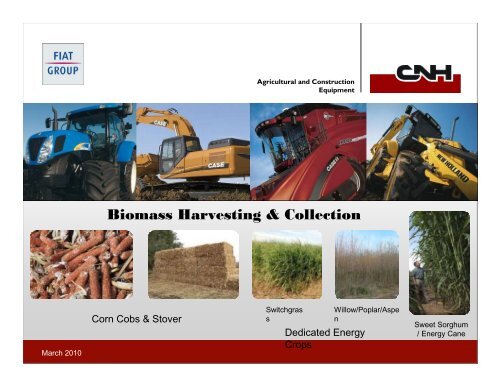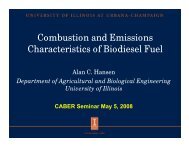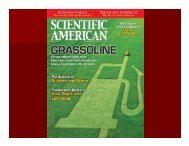Biomass Harvesting & Collection - Center for Advanced BioEnergy ...
Biomass Harvesting & Collection - Center for Advanced BioEnergy ...
Biomass Harvesting & Collection - Center for Advanced BioEnergy ...
Create successful ePaper yourself
Turn your PDF publications into a flip-book with our unique Google optimized e-Paper software.
Agricultural and ConstructionEquipment<strong>Biomass</strong> <strong>Harvesting</strong> & <strong>Collection</strong>March 2010Corn Cobs & StoverSwitchgrassDedicated EnergyCropsWillow/Poplar/AspenSweet Sorghum/ Energy Cane
CNH has a vested interest in the feedstock production and feedstock logisticsCurrent planting and seeding equipment is being evaluated in a variety of feedstock crops, i.e.,switchgrass, energy, grain and sweet sorghumHarvest and <strong>Collection</strong> of Feedstocks Require Focused Product DevelopmentThe overall objective of the Plat<strong>for</strong>m's Harvest and <strong>Collection</strong> R&D is to develop cost effective and sustainableharvest technologies and practices through the development of advanced harvesting equipment – and through thedevelopment of predictive models capable of identifying the impacts of agronomic and agribusiness practices onfeedstock sustainability. As such, this ef<strong>for</strong>t focuses on advanced engineering systems, sustainable practices, and therelationship between the two. The specific objectives of Harvest and <strong>Collection</strong> ef<strong>for</strong>ts are to identify the requirementsand specifications needed to engineer advanced harvesting systems; identify the factors that impact sustainability;develop tools to predict the potential consequences associated with conflicting biomass demands that affect food andfuel availability in the U.S; and identify actions to reduce potential impacts.Date 2
Near-Term Target ConsiderationsFEEDSTOCKENERGY &TECHNOLOGYREGIONDRIVERSPREDICTED ACREAGE /BIOMASS VOLUMECobs andstoverCellulosicethanol +combustion /gasificationMidwestUS• Appears poised as theprimary emergingfeedstock <strong>for</strong> cellulosicethanol (leading pilotprojects are using cobsand stover, or intend to.• Primary candidate <strong>for</strong>commercialized <strong>for</strong> UScellulosic ethanolproduction.• Est. corn acres (2016) = 91– 96 million.• Cob volume (2016) = 60 –82 million dry tons.• Stover volume (2016) = 116– 149 million dry tons (atsustainable removal rate of30%).SwitchgrassCellulosicethanol +combustion /gasificationSoutheastUS• Leading project developerusing switchgrass in pilotproject – Farmers havesigned on to grow <strong>for</strong> pilotproject.• Leading candidate tobecome commercialized<strong>for</strong> US cellulosic ethanolproduction following cobsand stover.• Acres (2016) = 15 – 20million• Volume (2016) = 75 – 100million dry tons.Date3
Near-Term Target ConsiderationsFEEDSTOCKENERGY &TECHNOLOGYREGIONDRIVERSPREDICTED ACREAGE /BIOMASS VOLUMEWheat strawCellulosicethanolCanadianPrairie• The leading Canadiancellulosic developer isusing wheat straw asprimary feedstock –farmers signed on andacres dedicated.• Primary candidate <strong>for</strong>near-term Canadiancellulosic ethanolproduction.• 1.5 – 2.6 dry tons / acre.• Total Canadian wheatacreage = 24.8 millionacres.• Est. total wheat strawavailable = 37 – 64 milliondry tons.Combustion /gasification cofiredpowerplantsEU(UK,Spain,Denmark)• Currently being used onsmall scale basis withpotential expanded use.• Pelleting R&D• 1.5 – 2.6 dry tons / acre.• Total EU wheat acreage =65.5 million acres.• Est. total wheat strawavailable = 98 – 170 milliondry tons.Date4
Near-Term Target ConsiderationsFEEDSTOCKENERGY &TECHNOLOGYREGIONDRIVERSPREDICTED ACREAGE /BIOMASS VOLUMEWood Crops(Poplar,willow, privatetimberplantations)Combustion <strong>for</strong>powerUS(Southeast,Northeast,NorthwestCanada(Westernand Eastern)• Currentlycommercialized in cogenerationoperations.• Utilities are consideringfollowing the EU woodco-firing model.• Pelleting expanding inthe US by EU firmsexporting pellets to EUpower companies.• Commercialized andexpanding cogenerationuse• Reportedly in woodycrop row cropping R&D• <strong>Biomass</strong> acreage is notreadily known.• USDA Forestry and<strong>Biomass</strong> R&D Boardestimate 42 – 104 milliondry tons available.•N/AChina• Reportedly woody croprow cropping inYunnana province•N/ADate5
Near-Term Target ConsiderationsFEEDSTOCKRENEWABLEENERGYPRODUCED &TECHNOLOGYREGIONDRIVERSPREDICTED ACREAGE /BIOMASS VOLUMESweetsorghumEthanolfermentation /anaerobicdigestionUSIndia,Australia,Uruguay• Reported test plots /field trials in Fla./La.• Developers reportedlyconducting ethanolconversion tests, andtest plots / field trials.• Est. acres (2014) = 0.4million• Est. volume = 18.8million tons• Est. acres (2014) = 0.35million• Est. volume = 18.6million tonsJatrophraBiodieseltransestrificationIndia• India governmentreportedly pushing thedevelopment ofjatrophra plantations.• One limitation is thetoxicity of jatrophrameal (no market)•N/AUS(SouthFlorida)• Developer reportedlyinvesting in 88 acreplantation.• Potential acres = 88Date6
Baling Corn Stover – Large Square; 3 x 4 SizeCurrent corn stover harvest technology (multiple operations)introduces significant amounts of dirt and rocks that contaminate thefeedstock bales and create additional costs at the bio-refinery.Seed and biofuel companies allowed CNH to participate in fielddemonstrations of corn stover harvest with current production largesquare balers. Monsanto and ADM have partnered in a multi-yearstudy to create an economic model <strong>for</strong> stover baling, transporting,storage and processing these feedstock bales <strong>for</strong> power generation.CaseIH supplied an LB433R <strong>for</strong> evaluation, The unit was fitted withheavy-duty pick-up teeth to handle the abrasive BT corn stalks.3’ X 4’ X 8’ bales range from 1,200 to 1,500 lbs., depending onmoisture content and density adjustments. 12.5 to 15.6 lbs./cu.ft.Typical productivity of LSB is about 40 tons/hourDate 7
Baling Corn Stover – 5’ X 6’ Round• Designed <strong>for</strong> higher per<strong>for</strong>mance and durability in crop conditions that can challenge other balers. This5’ x 6’ round baler features crop-specific technology that improves feeding and produces well-<strong>for</strong>med, tightbales in cornstalks, as well as in normal hay and straw crops. Compared to conventional four-bar pickups, thefive-bar XtraSweep 2.07m pickup is more durable when baling cornstalks, and provides more consistentfeeding in specialty and lighter crops. Tough, rein<strong>for</strong>ced rubber-mounted tines ensure reliable per<strong>for</strong>mance inheavy crops by improving crop gathering capability. Because they are flexible, the tines resist bending andbreaking and retain their <strong>for</strong>k design longer. When baling cornstalks, pick-up flares boost feeding and reduceplugging. An adjustable, easy-to-remove, two-piece wind guard improves feeding by reducing plugging in shortcrops while increasing capacity in big windrows. Any plugged residue can be cleaned out easily. Fingers onthe baler’s external expeller roll remove debris that builds up inside the belts. Bale <strong>for</strong>mation in all crops is alsoimproved by front belt guides, which ensures proper belt tracking and increases•5’ x 6’ bales range from 1,200 to 1,500 lbs., depending on moisture content and density adjustments. 8.5 to10.6 lbs./cu.ft.•Typical productivity of 5 X 6 round baler is about 20 tons/hourDate 8
Storage; Short & Long Term ScenariosLarge square stover bales covered with tarpsRound bales with net wrap2 high stack (8 X 8) of large squares wrappedwith in-line system from AndersonDate 9
Baling Handling Bale handling, transporting and stacking‣ Bale accumulators <strong>for</strong> the large square balers to allow the operator to optimize off-loading of balesnear ends of field‣ Self-propelled bale wagon to pick-up, transport and stack the 3’x4’ baleso Capacity of current model is 10 bales‣ Telehandlers & Tractors w/loaders may be utilized in re-stacking and loading trucks at designateddistribution sitesDate 10
Most Economical Transportation Advantages of 3’x4’ bales versus small square, 4’x4’ and rounds.‣ The 3’x4’ allows a better fit <strong>for</strong> transporting on semi trailersooMore density (lbs/cu.ft.), 36 bales per 48’ trailerMaximize payload per trip to processing plantBales Ave. Weight Total PayloadModel Load Layout Per Load (lbs.) (#Bales x Weight)3 X 33 X 44 X 43 Wide, 3 High, 6Long 54 1000 54,0002 Wide, 3 High, 6Long 36 1500 54,0002 Wide, 2 High, 6Long 24 1800 43,200o20% increase in truck payloadDate 11
Logistics and Transportation The current strategy is to create local, onfarm ,distribution sites <strong>for</strong> the short-termstorage of feedstock bales. This will mostlikely be a custom hauling businessopportunity as the plants come on-line. Logistics of the feedstock will be the greatestchallenge; the reality is, very few farms/fieldswill be this close to a biorefinery‣ Transportation of the feedstocks could be 30 –50 miles one way‣ Example of truck flow; plant capacity –800,000 DM tons/year; over 31,000 truckloads of large square bales (7.5 trucks perhour, 14 hours/day, 6 days/week, 50weeks/year)Date12
CNH – New Holland’s 130FB Coppice HeaderIn 2009 New Holland released limited quantities of the 130 FB coppice header as anoptional header configuration <strong>for</strong> the FR Series Forage Harvesters. The FR9060 that is partof the CNH Innovation Organization has been involved in multiple harvesting scenarios offast growing willow, poplar, aspen and cottonwood. For 2010 and 2011, CNH, StateUniversity of NY and Greenwood Resources have been given a DOE grant <strong>for</strong> $1.2M tofurther develop the entire process from planting to harvesting to power generation and/orcellulosic conversion to ethanol. The New Holland SPFH and coppice head harvested atmultiple research locations in the U.S., including SUNY in New York, Oregon and U ofMinnesota at Waseca. Energy sorghum was also evaluated with the FR9060 and Kempernon-row sensitive header at Texas A&M.Date
<strong>Biomass</strong> header 130 FB•Test results UK•FR 9060 with coppice header•Willow (5-6m, 7-8 cm dia)•6-7 kmh capacity (2 ha/h)•Clean stubbleDate
Self-Propelled Forage Harvester <strong>for</strong> Biogas Production• FR9000 with Direct Cut Header 570 FW• Energy source: methane gas from fermentation in biogas installations• Crops harvested: corn, rye, grassDate15
Miscanthus Chop and Bale - EuropeDate 16
Energy Sorghum Chop and Bale – Texas A&MDate 17
Future Concepts Being EvaluatedCob collection carts; may just be a short term solutionDevelopment of higher density balers; > 25% increaseDevelopment of a single-pass harvester capable of selectivebiomass harvest‣ Corn stover, straw, etc.‣ Baling/packaging; modified large square balers‣ Pre-processing feedstock; utilize <strong>for</strong>age harvester cuttingcomponents‣ Transporting to end of fields; capacity to allow combine to operatewith same efficiency as today’s unitsDate 18
Thank YouDate 19





